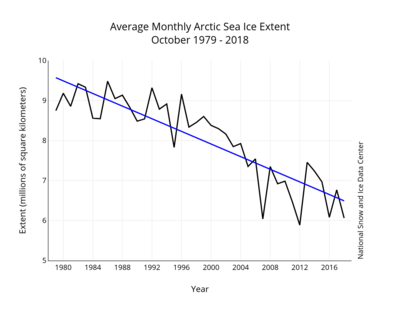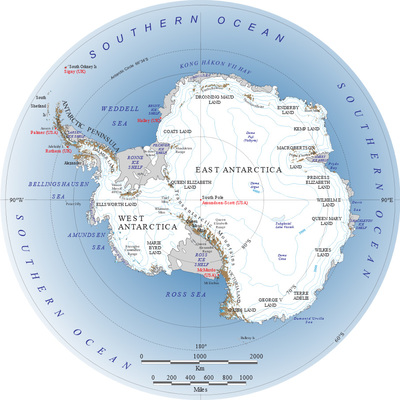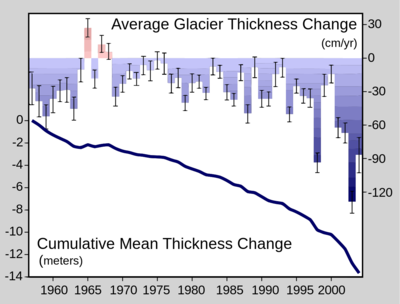Cryospheric (Ice) Problems of Climate Change
Decrease in Arctic Sea Ice

Arctic Sea Ice Extent for October 1979-2018
National Snow and Ice Data Center
Arctic Sea Ice has been steadily declining for years, due to global warming of both the atmosphere and the oceans. The above graph shows the sea ice extent for October for the years 1979-2018.
Cryosphere: NOAA Arctic Video 2017
The following video is from the Arctic Program of the National Oceanic and Atmospheric Administration (NOAA) website
Decrease in the Greenland Ice Sheet
The following video is from NASA's Global Climate Change website
An ice sheet is a mass of land-based ice with a size greater than 50,000 square kilometers (20,000 square miles). Today there are two ice sheets in existence - the Greenland ice sheet and the Antarctic ice sheet.
The Greenland ice sheet is melting and has been doing so for several decades, but since the early 1990's it has been melting at an accelerating pace, due to a number of influencing factors. Greenland currently loses on average about 270 billion tons of ice each year. What are the reasons for this dramatic loss of ice? The following is a list of some of the factors that contribute overall to the ice sheet melting:
- Increasing atmospheric temperature due to global warming
- A decade of atmospheric blocking with warm air stalling over Greenland
- A warming phase in the Atlantic Ocean circulation cycle
- Growth of many types of microbes that darken the ice and snow and increase absorption of solar radiation
Decrease in Antarctic Ice Sheet

Antarctic Continent
An ice sheet is a mass of land-based ice with a size greater than 50,000 square kilometers (20,000 square miles). Today there are two ice sheets in existence - the Greenland ice sheet and the Antarctic ice sheet.
The Antarctic ice sheet covers almost 14 million square kilometers (5.4 million square miles). However, there is mounting evidence that Antarctica is losing ice, mostly along the Amundsen Sea coast, located at the southwest region of West Antarctica.
Antarctic ice shelf mass loss

West Antarctic Venable Ice Shelf
Source: NASA Global Climate Change
Ice on the Antarctic continent is melting. There are two mechanisms for the melting - calving of ice around the edges of the shelf, forming icebergs and basal melting of the ice from below. NASA research has shown that ice loss from basal melting exceeds the rate of ice loss from iceberg formation.
For more information on this phenomenon, go to NASA Global Climate Change
Cryosphere: Retreat of Glaciers

Changes in Glacial Thickness Worldwide
Source: The National Snow and Ice Data Center
Almost all glaciers worldwide are retreating and declining in thickness. The above image shows the average decrease in thickness of mountain glaciers around the world.
For extensive information on glaciers in all parts of the world, as well as for other ice forms, visit The National Snow and Ice Data Center
Thawing of Methane Hydrates
Permafrost is ground that remains at the freezing point of water for two or more years. Most permafrost is located in the Arctic and Antarctic polar regions. However, some permafrost can be found in lower latitudes at high altitudes. In ground locations permafrost often contains frozen water with methane trapped within. Such forms of ice are referred to a methane hydrate. In the Arctic Ocean, methane hydrates can also be found undersea on continental shelves surrounding the Arctic.
Methane hydrates are a form of clathrates, which are frozen crystals that can bind molecules of other substances within its crystalline structure. Methane hydrates have methane held within ice crystals that constitute the clathrate. When temperatures rise and methane hydrates melt, the bound methane is released. Climate change can cause that warming, which becomes a positive feedback loop, with the released methane entering the atmosphere and causing more global warming, due to its powerful property as a greenhouse gas.